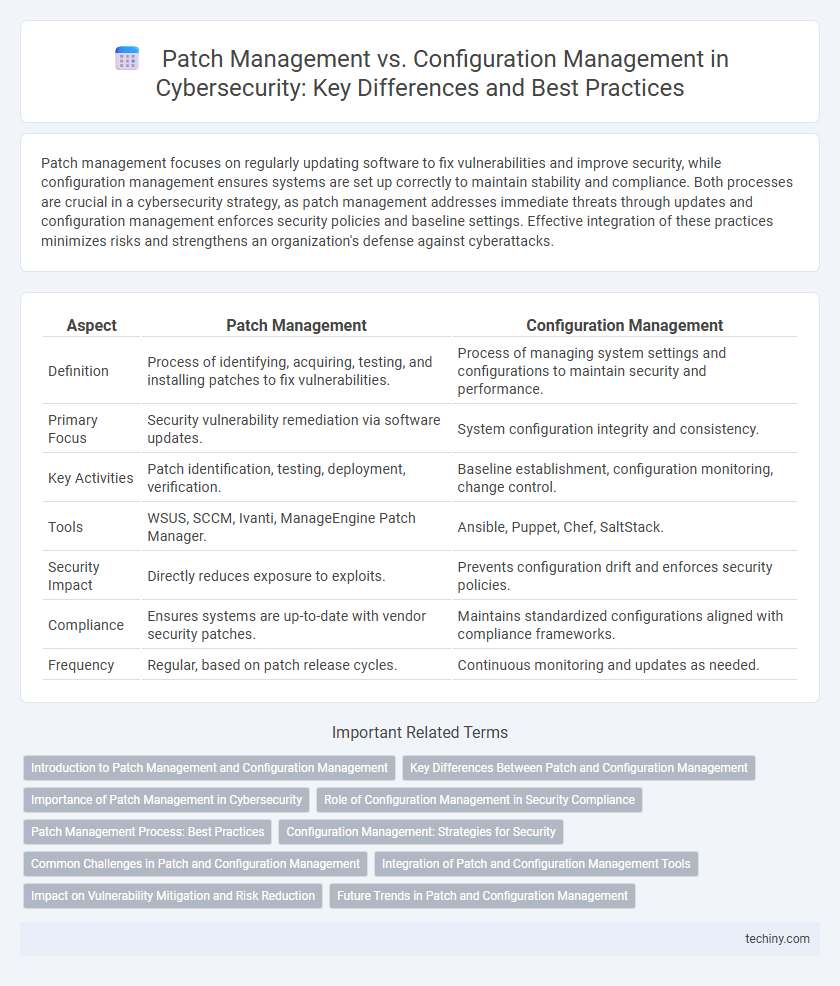Patch management focuses on regularly updating software to fix vulnerabilities and improve security, while configuration management ensures systems are set up correctly to maintain stability and compliance. Both processes are crucial in a cybersecurity strategy, as patch management addresses immediate threats through updates and configuration management enforces security policies and baseline settings. Effective integration of these practices minimizes risks and strengthens an organization's defense against cyberattacks.
Table of Comparison
| Aspect | Patch Management | Configuration Management |
|---|---|---|
| Definition | Process of identifying, acquiring, testing, and installing patches to fix vulnerabilities. | Process of managing system settings and configurations to maintain security and performance. |
| Primary Focus | Security vulnerability remediation via software updates. | System configuration integrity and consistency. |
| Key Activities | Patch identification, testing, deployment, verification. | Baseline establishment, configuration monitoring, change control. |
| Tools | WSUS, SCCM, Ivanti, ManageEngine Patch Manager. | Ansible, Puppet, Chef, SaltStack. |
| Security Impact | Directly reduces exposure to exploits. | Prevents configuration drift and enforces security policies. |
| Compliance | Ensures systems are up-to-date with vendor security patches. | Maintains standardized configurations aligned with compliance frameworks. |
| Frequency | Regular, based on patch release cycles. | Continuous monitoring and updates as needed. |
Introduction to Patch Management and Configuration Management
Patch Management involves identifying, acquiring, and deploying software updates to fix vulnerabilities, enhance security, and ensure system integrity. Configuration Management focuses on maintaining and controlling system settings and configurations to prevent unauthorized changes and reduce security risks. Both processes are critical in cybersecurity to safeguard IT environments against threats and maintain compliance.
Key Differences Between Patch and Configuration Management
Patch management involves the systematic process of identifying, acquiring, testing, and installing software updates to fix vulnerabilities and improve security. Configuration management focuses on maintaining consistency of system settings, hardware, and software configurations to ensure operational integrity and compliance. The key difference lies in patch management addressing security flaws through updates, while configuration management enforces standardized environments to prevent unauthorized changes.
Importance of Patch Management in Cybersecurity
Patch management is critical in cybersecurity for closing security vulnerabilities by applying software updates that fix bugs and protect systems from exploits. Regularly updating patches reduces the attack surface, preventing malware, ransomware, and data breaches caused by outdated software. Effective patch management ensures compliance with industry standards like NIST and enhances overall network resilience against evolving cyber threats.
Role of Configuration Management in Security Compliance
Configuration management plays a critical role in security compliance by systematically tracking and controlling all changes to IT assets, ensuring that systems remain secure and aligned with established policies. It helps enforce security baselines, detect unauthorized alterations, and maintain audit trails necessary for regulatory requirements such as HIPAA, GDPR, and PCI DSS. Effective configuration management reduces vulnerabilities and supports continuous compliance by providing visibility into system states and facilitating rapid remediation of security misconfigurations.
Patch Management Process: Best Practices
Effective patch management processes prioritize timely identification, testing, and deployment of security patches to minimize vulnerabilities in IT systems. Best practices include maintaining an accurate asset inventory, automating patch deployment, and regularly verifying patch effectiveness through continuous monitoring and auditing. Consistent communication between IT teams and stakeholders ensures alignment on patch prioritization based on risk assessment and compliance requirements.
Configuration Management: Strategies for Security
Configuration management enhances cybersecurity by maintaining consistent system settings across an IT environment, reducing vulnerabilities caused by misconfigurations. Effective strategies include automated configuration baselines, continuous monitoring, and strict access controls to detect and remediate unauthorized changes promptly. Integrating configuration management with security frameworks ensures compliance and improves incident response efficiency.
Common Challenges in Patch and Configuration Management
Common challenges in patch and configuration management include managing the complexity of diverse IT environments with numerous devices and software versions, leading to inconsistent patch deployment and configuration standards. Security teams often struggle with maintaining up-to-date vulnerability assessments while minimizing system downtime and avoiding configuration drift. Limited visibility into asset inventory and lack of automation further exacerbate the risks of overlooked patches and misconfigured systems, increasing the attack surface.
Integration of Patch and Configuration Management Tools
Integrating patch management with configuration management tools enhances cybersecurity by enabling automated, consistent deployment of updates aligned with predefined system settings. This integration reduces vulnerabilities by ensuring configurations are compliant and patches are uniformly applied across all endpoints. Centralized visibility and control streamline the remediation process, improving overall risk management and system resilience.
Impact on Vulnerability Mitigation and Risk Reduction
Patch management directly addresses vulnerabilities by applying software updates that fix security flaws, thereby reducing the attack surface and mitigating risks caused by known exploits. Configuration management ensures systems adhere to secure baseline settings, preventing misconfigurations that could be exploited by attackers and reducing the likelihood of security breaches. Together, these processes create a robust defense by continuously closing vulnerabilities through patches while maintaining secure system states to minimize risk exposure.
Future Trends in Patch and Configuration Management
Emerging trends in patch and configuration management emphasize automation driven by artificial intelligence and machine learning to enhance vulnerability detection and remediation speed. Cloud-native environments and containerization demand adaptive patching strategies integrated with orchestration platforms like Kubernetes for seamless updates. Zero-trust architectures further influence configuration management by enforcing continuous compliance and dynamic access controls to mitigate evolving cyber threats.
Patch Management vs Configuration Management Infographic

 techiny.com
techiny.com